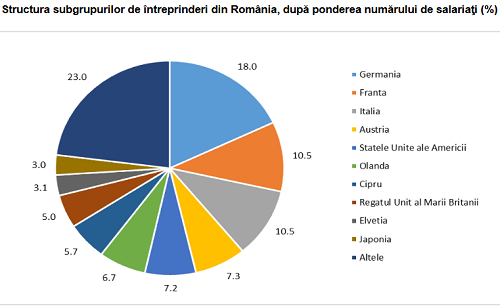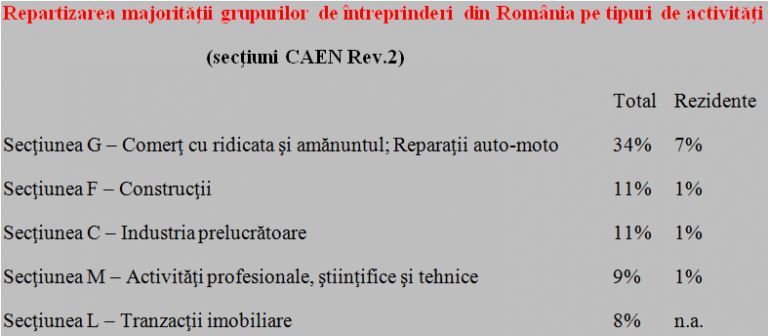 Germany (18.5%), France (10.5%) and Italy (10.5%) are the countries with the largest share of Romania’s economy by the number of employees working in 73,663 groups of companies, according to data processed for 2015 and published at the end of April by INS.
Germany (18.5%), France (10.5%) and Italy (10.5%) are the countries with the largest share of Romania’s economy by the number of employees working in 73,663 groups of companies, according to data processed for 2015 and published at the end of April by INS.
Along with Austria (7.3%), the US (7.2%) and the Netherlands (6.7%), they control over 60% of the existing groups of companies from our national economy.
*
- Structure of the subgroups of companies from Romania, by number of employees
*
Only slightly more than 7% of these groups have been identified as residents by the official statistics, while no less than 68,194 groups have been identified as multinational enterprises.
That is true, 152 (0.22%) of them were controlled from inside the country and only 68,042 (99.78%) from abroad.
*
- Structure of the majority of the groups of enterprises from Romania, by type of activity (CAEN sections, rev2) Total Resident
- Section G – retail and wholesale retail; auto repairs
- Section F- Construction
- Section C- Manufacturing
- Section M- Professional, scientific and technical activities
- Section L – Real estate
*
Most of the resident groups of companies operate predominantly in the following sections: G – Wholesale and retail trade; repair of motor vehicles and motorcycles – where they represent only 20%, S – Other service activities – 17%, M – Professional, scientific and technical activities – 12%, C – Manufacturing – 10% and F – Construction – 10%.
If these percentages are applied to those that these sections have in the whole groups, we obtain rates around 7% only in the trade and repair field and almost reach the psychological threshold of 1% in three areas: Manufacturing, Construction and Professional, scientific and technical activities.
That shows a marginal presence of the domestic capital and a strong concentration, on the foreign side, of the decisions made in the economy, let’s call it Romanian for geographical and workforce related reasons. Of course, there are also numerous small enterprises which are not part of any group and belong, most of them, to the Romanians. But that is not where important decisions are taken.
So, without us lamenting and wondering about the advance of globalization and the openness offered by the unification of markets within the EU (we can easily notice that the three countries with the most important shares in the economy are also the largest trade partners), maybe we should calibrate more carefully our government policies.
We should also distinguish between Romania’s economy, predominantly controlled from abroad, and the economy of Romanians (by place of residence), with most of the companies (by number) being local ones.
Definitions
Legal entity means any economic or social operator that has its own patrimony, can conclude contracts in his own name with third parties and defend its interests in court – has legal personality. Legal entities are either authorized natural persons, individual enterprises, family businesses (in their capacity as entrepreneurs) or legal entities.
Control – a legal entity is controlled if another legal entity holds a share exceeding strictly 50% in the decision-making process from the general meeting of the shareholders, or which, by contract, has the right to control.
Group – the multitude of enterprises linked to a group head through a real non-zero control quota
Group head – a legal entity, neither directly, nor indirectly controlled by any other legal entity and controlling at least one subsidiary
Multinational group of companies – a group of enterprises comprising at least two legal entities located in different countries
Subgroup of companies – legal entities (enterprises) of a group of multinational enterprises that are resident in the same country
Resident group – a group of enterprises whose legal entities (businesses) are all resident in the same country.
Source: INS











